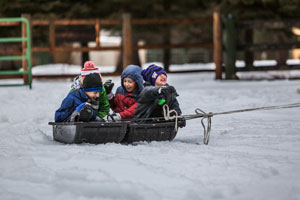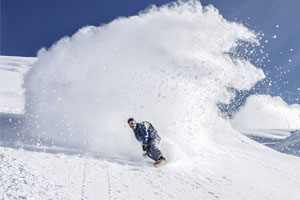Winter Shouldn’t Stop You
Winter Shouldn’t Stop You
Tips for Preventing Injuries While Participating in Winter Sports

More than 290,000 hospitalizations occur from winter sports injuries, with 193,000 attributed to mountain sports. More than 47,000 injuries occur from ice skating sports such as hockey and figure skating while 52,000 occur during sledding or snow tubing accidents. Due to the rural nature of some winter sports, they should never be performed alone. In the case of an accident, the other person may contact emergency support services.
Audra Molina, a nurse practitioner at the Larry Combest Community Health and Wellness Center stated they tend to see more slipping injuries during winter.
“Wearing appropriate shoes with tread can decrease the risk of slipping and falling,” Molina said. “When it comes to falls, however, we tend to see a high number of head injuries. Always wear a helmet when taking part in winter sports and never go out by yourself.”
Winter sports have a higher risk of falls, which can cause injuries to knees, arms and shoulders while putting athletes at risk for concussions. Skiers commonly tear their anterior cruciate ligament, or ACL, while erring on their skis. Bindings should always be tested and muscles should be warmed up before participating. Beginners should seek the training of professional instructors to learn how to perform basic maneuvers, such as how to fall correctly to reduce the risk of injury.

Although less skin is being exposed to the outside elements, wet clothes can cause skin irritations and infections. Blisters form from friction with wet socks and ill-fitting shoes. It is important to layer clothes in a way that will not cause rubbing. Layering clothes also helps athletes to accommodate their fluctuating body temperature.
“Layering with a waterproof outer shell is the key to staying comfortable,” Molina said. “Sunscreen is equally important to protecting skin, despite most skin being covered by heavy coats and jackets. More radiation actually hits the skin when there is snow on the ground. Many people mistake their sunburns for frostbite. Any part of the skin that is exposed should be covered in sunscreen.”
Up to 80 percent of ultraviolet (UV) rays – double the typical dose of UV radiation on a sandy beach – are reflected off snow and back up into the atmosphere, creating another source of radiation through reflected light. To avoid irritation, carry a high-SPF lip balm to apply to the nose and lips, lather up on sunscreen and wear sunglasses or goggles to avoid snow blindness, which is actually a sunburn on the eye.
Molina said it is always best to check the weather before participating in any winter activities. Being well-prepared is the best way to keep athletes performing at their best.

Related Stories
How Does Your Garden Grow?
As spring approaches, some people’s thoughts turn to gardening. Whether it’s a flower garden they desire or a vegetable garden want to have, they begin planning what they’ll plant and what they need to do to ensure a successful garden.
Adopt a Growth Mindset for a Better Life
A “growth mindset” accepts that our intelligence and talents can develop over time, and a person with that mindset understands that intelligence and talents can improve through effort and learning.
Drug Use, Family History Can Lead to Heart Disease in Younger Adults
Abstaining from drug abuse and an early diagnosis of familial hypercholesterolemia (high cholesterol) can help prevent heart disease.
Recent Stories
TTUHSC, TTU School of Veterinary Medicine Recognize Student Research During Inaugural Amarillo Research Symposium
More than 100 student and trainee researchers from the TTUHSC and the TTU School of Veterinary Medicine presented research findings at the 2024 Student Research Day on April 19.
The TTUHSC Laura W. Bush Institute for Women’s Health Welcomes Ben Carson as Power of the Purse Keynote Speaker
Retired neurosurgeon and former U.S. Secretary of Housing and Urban Development Ben Carson, M.D., delivered a keynote address at the Power of the Purse luncheon and fundraiser today (April 18).
Filling the Gap: PA Impact on Rural Health Care
Assistant Professor and Director of Clinical Education Elesea Villegas, MPAS, PA-C, spoke about the challenges rural health care currently faces and how PAs are stepping up to better serve the rural patient population.
